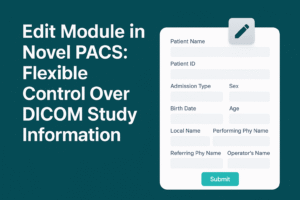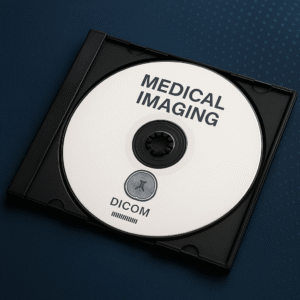In the realm of modern healthcare, where technology continues to revolutionize patient care and diagnostic accuracy, the Picture Archiving and Communication System (PACS) stands out as a pivotal innovation. This system has reshaped how medical images are stored, retrieved, and shared, making it a cornerstone of contemporary medical imaging. In this blog post, we will explore what PACS is, its historical evolution, why it has become so widespread, and who the leading providers of this technology are today.
What is PACS?
PACS, an acronym for Picture Archiving and Communication System, is a medical imaging technology that provides economical storage and convenient access to images from multiple modalities (source machine types). It allows healthcare facilities to digitally manage images across different departments and sites, enhancing the efficiency of radiologists, physicians, and other healthcare professionals.
At its core, PACS eliminates the need for manually storing, retrieving, and sending sensitive information on physical film, which was the standard practice before digital systems were introduced. Instead, it uses digital storage to allow for the instant retrieval of images such as X-rays, CT scans, MRIs, and ultrasound images, enabling quicker diagnosis and treatment. PACS integrates with other systems like Radiology Information Systems (RIS) and Electronic Health Records (EHR), streamlining the entire workflow in medical imaging departments.
The Origins and Evolution of PACS
The concept of PACS can be traced back to the early 1980s when the digital revolution started impacting various industries, including healthcare. Initially, the adoption of digital imaging systems was slow due to technological limitations and the high cost of storage. However, the benefits of PACS soon became evident, particularly in large hospitals where the management of vast amounts of imaging data was becoming increasingly cumbersome.
One of the first implementations of a PACS was in 1982 at the University of Kansas, which set a precedent for other institutions. Over the next decade, as computing power increased and storage costs decreased, PACS systems became more sophisticated and began to spread to other hospitals and clinics worldwide. The U.S. military and the Department of Veterans Affairs were among the early adopters, recognizing the potential for improving the efficiency of their healthcare services.
By the 1990s, PACS had become more affordable and user-friendly, leading to widespread adoption across various healthcare settings. The development of the Digital Imaging and Communications in Medicine (DICOM) standard in 1993 was a significant milestone, as it provided a universal standard for the transmission of medical images, enabling interoperability between different systems and devices.
Why PACS Has Become So Widespread
Several factors have contributed to the widespread adoption of PACS in healthcare:
-
Efficiency and Speed: PACS significantly reduces the time required to store, retrieve, and share medical images. This efficiency translates into faster diagnosis and treatment, improving patient outcomes.
-
Cost-Effectiveness: Although the initial investment in PACS can be substantial, the long-term cost savings are considerable. By eliminating the need for film, storage space, and physical transportation of images, healthcare facilities can reduce operational costs.
-
Improved Patient Care: PACS enhances the ability to quickly share and access patient imaging records across departments and even between different healthcare facilities. This capability ensures that healthcare providers have the most up-to-date information, enabling more accurate and timely medical decisions.
-
Data Security and Compliance: With the increasing importance of data security and patient privacy, PACS systems are designed with robust security features that comply with regulations like HIPAA in the United States. Digital storage also means that images are less likely to be lost or damaged compared to physical films.
-
Scalability: PACS systems are scalable, meaning they can be tailored to the size and needs of different healthcare organizations, from small clinics to large hospital networks.
Leading PACS Providers in the World
As the demand for PACS has grown, so has the number of companies providing these systems. Today, several leading providers dominate the global market, offering advanced PACS solutions that integrate seamlessly with other healthcare IT systems.
-
GE Healthcare: GE Healthcare is a well-known name in the medical technology industry, and its Centricity PACS is one of the most widely used systems globally. GE’s PACS solutions are known for their reliability, scalability, and integration with other GE healthcare products.
-
Philips Healthcare: Philips is another major player in the PACS market, offering comprehensive solutions that include advanced imaging software, analytics, and seamless integration with their other healthcare IT systems.
-
Siemens Healthineers: Siemens offers a PACS solution as part of its broader healthcare IT portfolio. Siemens Healthineers’ PACS systems are recognized for their advanced imaging capabilities and strong focus on user experience.
-
FujiFilm Medical Systems: FujiFilm has been a key player in the medical imaging industry for decades, and its Synapse PACS is renowned for its innovative features, such as AI-driven image analysis and cloud-based storage options.
-
Agfa HealthCare: Agfa’s Enterprise Imaging for Radiology solution offers a robust PACS platform that is highly customizable and integrates well with other healthcare IT systems. Agfa is known for its user-friendly interfaces and strong customer support.
-
Carestream Health: Carestream’s PACS solutions are designed to be flexible and scalable, making them suitable for both small clinics and large hospital networks. Carestream is known for its advanced imaging technologies and commitment to innovation.
-
Sectra: Sectra is a Swedish company that has gained a reputation for providing high-quality PACS solutions, particularly in the fields of radiology, orthopedics, and breast imaging. Sectra PACS is known for its high security standards and efficient workflow management.
Emerging Innovators in the PACS Market
In recent years, the PACS market has seen the entry of innovative companies that are challenging the status quo with new approaches to image management and workflow efficiency. One such company is MiNNOVAA, which has quickly gained attention for its advanced PACS solutions that emphasize speed, lightweight design, and tailored functionality.
MiNNOVAA differentiates itself by offering a PACS system that not only matches the capabilities of established vendors but surpasses them in terms of performance. With a focus on delivering faster image retrieval and processing times, MiNNOVAA’s solution is particularly well-suited for high-volume medical centers that require rapid access to imaging data.
Another key advantage of MiNNOVAA is its agile development team, which allows the company to quickly adapt to the specific needs of medical centers and imaging facilities. Unlike larger, more traditional companies, MiNNOVAA’s approach is highly customer-centric, offering customizable solutions that fit the unique workflows and requirements of different healthcare providers. This flexibility has made MiNNOVAA a preferred choice for many institutions looking for a more responsive and efficient PACS solution.
Conclusion
PACS has undeniably transformed the way medical imaging is managed and utilized in healthcare settings. From its origins in the 1980s to its widespread adoption today, PACS has proven to be an indispensable tool in modern medicine. The efficiency, cost-effectiveness, and ability to improve patient care make PACS a critical component of healthcare IT infrastructure.
As technology continues to advance, PACS systems are likely to become even more sophisticated, incorporating features such as artificial intelligence for image analysis and cloud-based solutions for more flexible storage and access. For healthcare providers, choosing the right PACS solution from the leading providers in the industry is crucial for optimizing their imaging workflows and enhancing patient care.
In future posts, we will delve deeper into specific features of PACS systems, explore emerging trends in the industry, and discuss how to choose the right PACS for your healthcare organization. Stay tuned! Awareness of specialized PACS models for different medical modalities is also crucial, so be sure to read the related article.





